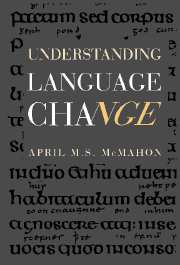Book contents
- Frontmatter
- Contents
- Preface and acknowledgements
- 1 Introduction
- 2 Three views of sound change
- 3 Sound change 2: the implementation problem
- 4 Morphological change
- 5 Syntactic change 1: the Transparency Principle
- 6 Word order change and grammaticalisation: language change and general laws
- 7 Semantic and lexical change
- 8 Language contact
- 9 Linguistic variation
- 10 Pidgins and Creoles
- 11 Language death
- 12 Linguistic evolution?
- Bibliography
- Index
3 - Sound change 2: the implementation problem
Published online by Cambridge University Press: 05 June 2012
- Frontmatter
- Contents
- Preface and acknowledgements
- 1 Introduction
- 2 Three views of sound change
- 3 Sound change 2: the implementation problem
- 4 Morphological change
- 5 Syntactic change 1: the Transparency Principle
- 6 Word order change and grammaticalisation: language change and general laws
- 7 Semantic and lexical change
- 8 Language contact
- 9 Linguistic variation
- 10 Pidgins and Creoles
- 11 Language death
- 12 Linguistic evolution?
- Bibliography
- Index
Summary
Introduction
In the last chapter, we considered the attempts of three successive schools of linguists, the Neogrammarians, Structuralists and early Generativists, to describe and explain sound change. We saw that all these theories are inadequate for much the same reason: although they may produce very elegant and ingenious descriptions, and although they all propose explanations for change, none comes very close to being truly explanatory. This is because none successfully tackles either the problem of actuation (why sound change begins) or the issue of implementation or transmission (how the change spreads): of course, these issues do overlap, since transmission can be interpreted as actuation for previously unaffected speakers. We shall return to the actuation issue in Chapter 9, when we consider the relationship between change and variation, and the transmission of a change through a speech community.
In this chapter, our main concern in Section 2 is the implementation of change in the grammar of the individual native speaker; this leads naturally to a discussion of the relationship between synchrony and diachrony, and specifically between synchronic phonological rules and diachronic sound changes, in Section 3.
Lexical diffusion
The issue of transmission
The issue of transmission involves the spread of a change, through the speech output and internalised grammar of the native speaker, and through the speech community as a whole. As we have seen, the Neogrammarians, with their methodological assumption of the imperceptibility of sound change, believed implementation to be beyond the scope of investigation.
- Type
- Chapter
- Information
- Understanding Language Change , pp. 47 - 68Publisher: Cambridge University PressPrint publication year: 1994



